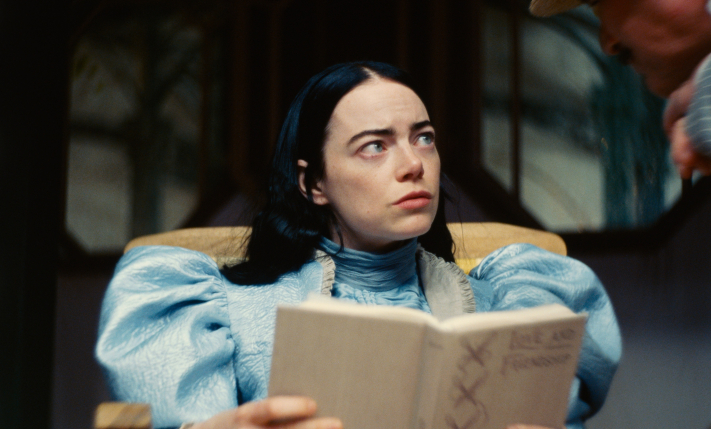There’s a lot of neat critical packaging of this film as ‘FrankenBarbie’. But that does a disservice to both Barbie and Poor Things (and Mary Shelley too).
Greta Gerwig, in all her films to date, takes aim at traditional expectations of young women. Whether it’s Lady Bird being dissuaded from going to university in New York, Jo struggling to be accepted as a writer in Little Women, or Barbie suddenly discovering that perfection may not be all it’s cracked up to be, her heroines fight for their roles with wit and determination.
Yorgos Lanthimos is preoccupied with something else entirely: the chaos and corruption underpinning apparently civilised society, and what one has to do to mature and survive in it. The fact that he keeps (in both his last two films anyway) illustrating this by making films in which Emma Stone has lots of sex, and is sent to a brothel to complete her emotional development, is an indication that the scope of his vision may be limited by his own very male gaze.
So Poor Things is not the flip side of the Barbie coin. It’s a bizarre and exotic currency of its own.
Frankenstein certainly looms large, with scenes of reanimated corpses and buzzing electricity (at one point I could almost sense Willem Dafoe desperate to shout, "It’s alive! Alive!") But that’s not the only old horror movie Lanthimos is tipping his Victorian top hat to here. John Gilling’s 1960 Burke and Hare body-snatching romp The Flesh and the Fiends hovers in the background, with Dafoe’s Dr Godwin Baxter acquiring bodies for his unconventional experiments.
Erle C. Kenton’s Island of Lost Souls from 1932, starring Charles Laughton as Dr Moreau with his private kingdom of failed genetic experiments mixing humans with animals, is also a key influence, not only with Baxter’s duck/dogs and pig/chickens, but also in his obsession with the young woman who is his greatest experiment. For Moreau it was Lola the Panther Woman; for Baxter it’s Bella. For both of them, they play God.
The film that casts its dirty shadow most completely over Poor Things is Rouben Mamoulian’s 1931 classic take on Dr Jekyll and Mr Hyde, starring Fredric March as the good (and bad) Doctor. The early scenes in lecture theatres are almost mirror images of Mamoulian’s original. But what really draws these two films together is their obsession with dual identity, and its expression through sex. Which is the real ‘you’? The scraps of bone and flesh stuffed inside your crinoline dress? Or the shapeless ego yelling for its own identity in the dark caverns of your mind?
These may be the ideas jockeying in the background of Lanthimos’s story. But ultimately he cares far more about aesthetics than issues. Visually, Poor Things is just outrageously original. It’s like being taken on a tour of the mind of an insane genius, as if Willy Wonka had a factory for making monsters instead of chocolate. The camera angles, the scenery, the effects, the costumes, even the script – all of them occupy the same (yes it’s that word again) liminal space between reality and madness. Just watching it is a head-spinning fairground ride, with a new thrill round every corner. And the glue that holds all this visual insanity together is: steampunk. Martin Scorsese dabbled with it in 2011’s Hugo. Terry Gilliam turned his own Heath Robinson cartoons into it with The Adventures of Baron Munchausen in 1988. But never has steampunk been so gloriously bodied forth on screen until Poor Things. The hackney carriage with a fake, steam-powered horse; the cable-cars with arcane Penny Farthing wheels; the motorised balloons hovering in the sky above Lisbon… every moment is a celebration of hallucinatory Victoriana. Bryan Talbot’s Grandville and Arkwright graphic novels are the only pieces of steampunk-infused art I can think of that keep up with designers Simon Hughes’ and Tallulah Baker’s breath-taking vision.
And at the heart of it all is Emma Stone’s Bella: a steampunk automaton that wants to be a real girl, like a randy, female Pinocchio. Stone’s performance has rightly led her to the brink of Oscar glory, although the character she most reminds me of is Truly Scrumptious in (another steampunk classic) Chitty Chitty Bang Bang, where she pretends to be a clockwork ballerina in the Doll on a Music Box sequence. Jerky, halting, determined, Stone somehow convincingly portrays a baby’s mind in a woman’s body. In the old days, of course, actors queued up to play disabled characters when they wanted praise from the Academy of Motion Pictures. Call me cynical, but I wonder if this is simply an evolution of the same idea.
One of the weaker points of the film is the near-afterthought appearance of Bella’s erstwhile husband Alfred Blessington (Christopher Abbott). He does the quickest volte-face imaginable from Prince Charming to evil sadist, and in a twinkling becomes the villain of the entire movie, condemned, in the final scene, to a lifetime as ‘chicken man’ (in yet another old-horror-film reference, this time to Tod Browning’s Freaks from 1932, one of the most unsettling and nearly unwatchable films ever made).
What's perhaps not made sufficiently clear is that Blessington is both Bella's father and husband. The genes she was trying to prevent from coming into the world when she committed suicide live not only with her but in her. That final scene shows that she has overcome not just her husband but also his dominion over her mind.
Blessington’s failings are more than made up for by Mark Ruffalo’s winningly over-the-top dastardly rake Duncan Wedderburn. Ruffalo, Dafoe and Stone, along with deliciously scene-chewing cameos from Hanna Schygulla as an unshockable tourist, Vikki Pepperdine as Dr Baxter's assistant, and Kathryn Hunter as the philosophical brothel-owner, make Poor Things a perfect unity of design, direction and performance. Now, if only Yorgos Lanthimos could find another way for his heroines to discover themselves beyond their sexuality, I think he would really be on to something.




